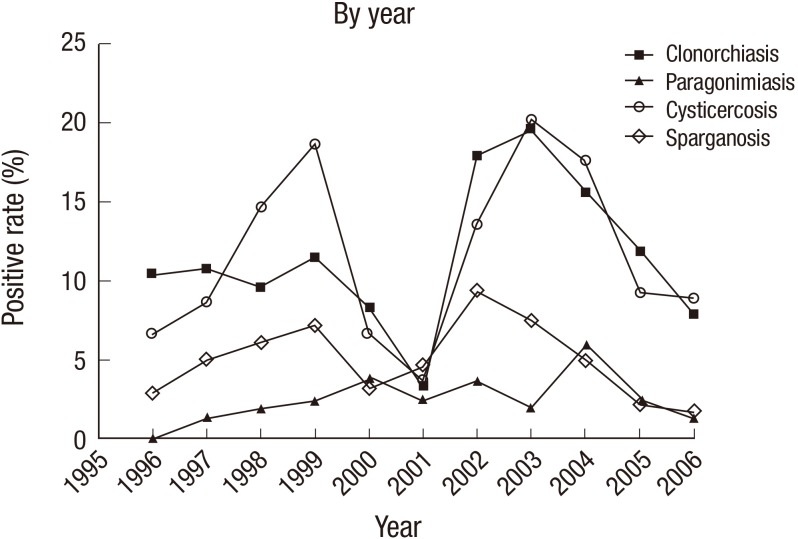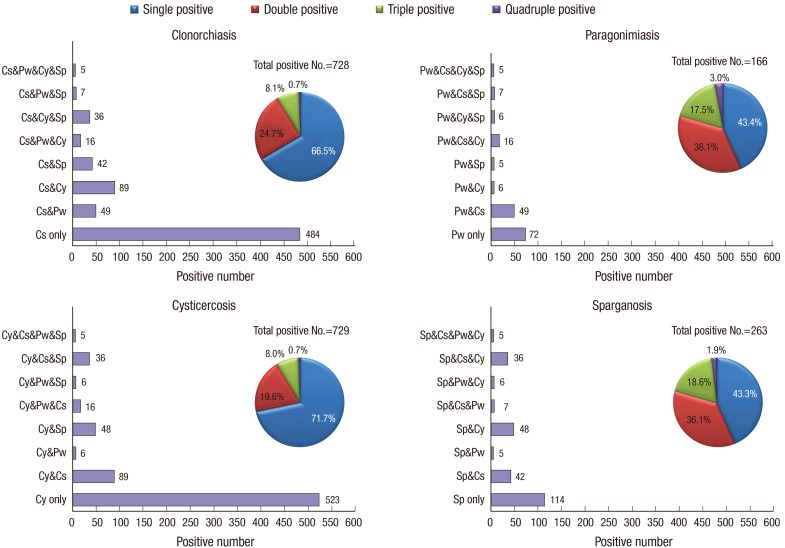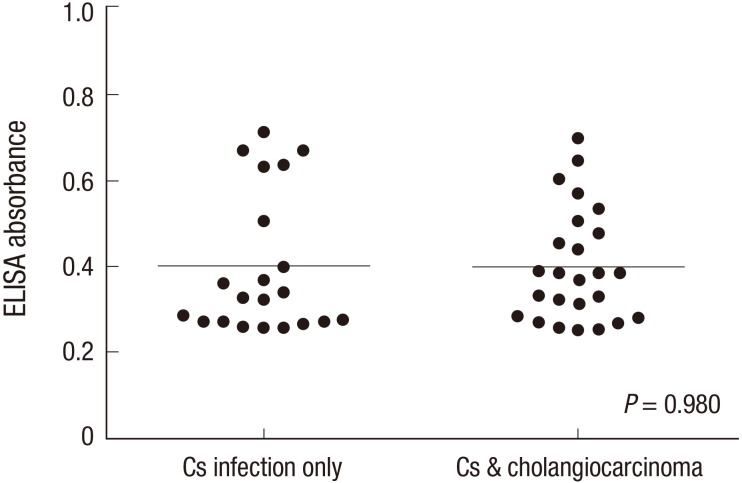J Korean Med Sci.
2017 Jul;32(7):1118-1123. 10.3346/jkms.2017.32.7.1118.
Significance of Serology by Multi-Antigen ELISA for Tissue Helminthiases in Korea
- Affiliations
-
- 1Department of Microbiology, Dongguk University College of Medicine, Gyeongju, Korea.
- 2Department of Environmental Medical Biology and Arthropods of Medical Importance Resource Research Bank, Institute of Tropical Medicine, Yonsei University College of Medicine, Seoul, Korea.
- 3Department of Parasitology and Tropical Medicine, Institute of Endemic Diseases, Seoul National University College of Medicine, Seoul, Korea. hst@snu.ac.kr
- 4Division of Infectious Diseases, Department of Internal Medicine, Seoul National University College of Medicine, Seoul, Korea.
- KMID: 2379606
- DOI: http://doi.org/10.3346/jkms.2017.32.7.1118
Abstract
- It is clinically important to differentiate tissue-invading helminthiasis. The purpose of this study was to assess the specific immunoglobulin G (IgG) antibody positive rates for clonorchiasis, paragonimiasis, cysticercosis, and sparganosis 4 helminthiases from 1996 to 2006 using multi-antigen enzyme-linked immunosorbent assay (ELISA) in Korea. Results of 6,017 samples, which were referred to our institute for serodiagnosis, were analyzed. The subjects with positive serum IgG antibodies were 1,502 (25.0%) for any of the 4 helminthiases. The overall positive numbers for clonorchiasis, paragonimiasis, cysticercosis, and sparganosis were 728 (12.1%), 166 (2.8%), 729 (12.1%), and 263 (4.4%), respectively. The positive serologic reaction to multi-antigens was determined in 309 (20.6%) of the 1,502 total seropositive subjects. Those with multi-antigen positivity were regarded as positive for the antigen of strongest reaction but cross-reaction to others with weak positive reaction. Annual seropositive rates for those 4 tissue helminthiases ranged from 12.1% to 35.7%. The highest rate was observed in age from 60 to 69 years old and prevalence of men (27.4%; 1,030/3,763) was significantly higher than of women (19.1%; 332/1,741). Hospital records of 165 ELISA positive patients were reviewed to confirm correlation with their clinical diagnosis. Paragonimiasis was highly correlated as 81.8% (9/11), cysticercosis 29.9% (20/67), clonorchiasis 29.0% (20/69), and sparganosis 11.1% (2/18). In conclusion, the multi-antigen ELISA using 4 helminth antigens is useful to differentiate suspected tissue-invading helminthiases, especially ELISA diagnosis of paragonimiasis is reliable. The seropositivity is still high among suspected patients in Korea.
Keyword
MeSH Terms
Figure
Reference
-
1. Hong ST, Chai JY, Choi MH, Huh S, Rim HJ, Lee SH. A successful experience of soil-transmitted helminth control in the Republic of Korea. Korean J Parasitol. 2006; 44:177–185. PMID: 16969055.2. Cho SH, Lee KY, Lee BC, Cho PY, Cheun HI, Hong ST, Sohn WM, Kim TS. Prevalence of clonorchiasis in southern endemic areas of Korea in 2006. Korean J Parasitol. 2008; 46:133–137. PMID: 18830051.3. Lee MK, Hong SJ, Kim HR. Seroprevalence of tissue invading parasitic infections diagnosed by ELISA in Korea. J Korean Med Sci. 2010; 25:1272–1276. PMID: 20808668.4. Choi MH, Park IC, Li S, Hong ST. Excretory-secretory antigen is better than crude antigen for the serodiagnosis of clonorchiasis by ELISA. Korean J Parasitol. 2003; 41:35–39. PMID: 12666728.5. Kim YJ, Lee SM, Choi GE, Hwang SH, Kim HH, Lee EY, Chang CL. Performance of an enzyme-linked immunosorbent assay for detection of Clonorchis sinensis infestation in high- and low-risk groups. J Clin Microbiol. 2010; 48:2365–2367. PMID: 20421441.6. Cho SY, Hong ST, Rho YH, Choi SY, Han YC. Application of micro-ELISA in serodiagnosis of human paragonimiasis. Korean J Parasitol. 1981; 19:151–156.7. Cho SY, Kim SI, Kang SY, Choi DY, Suk JS, Choi KS, Ha YS, Chung CS, Myung HJ. Evaluation of enzyme-linked immunosorbent assay in serological diagnosis of human neurocysticercosis using paired samples of serum and cerebrospinal fluid. Korean J Parasitol. 1986; 24:25–41.8. Kim H, Kim SI, Cho SY. Serological diagnosis of human sparganosis by means of micro-ELISA. Korean J Parasitol. 1984; 22:222–228.9. Cui J, Li N, Wang ZQ, Jiang P, Lin XM. Serodiagnosis of experimental sparganum infections of mice and human sparganosis by ELISA using ES antigens of Spirometra mansoni spargana. Parasitol Res. 2011; 108:1551–1556. PMID: 21181193.10. Speiser F. Serodiagnosis of tissue dwelling parasites: application of a multi-antigen enzyme-linked immunosorbent assay (ELISA) for screening. Ann Soc Belg Med Trop. 1982; 62:103–120. PMID: 6756324.11. Jeong YI, Shin HE, Lee SE, Cheun HI, Ju JW, Kim JY, Park MY, Cho SH. Prevalence of Clonorchis sinensis infection among residents along 5 major rivers in the Republic of Korea. Korean J Parasitol. 2016; 54:215–219. PMID: 27180582.12. Yeo IS, Yong TS, Im K. Serodiagnosis of human sparganosis by a monoclonal antibody-based competition ELISA. Yonsei Med J. 1994; 35:43–48. PMID: 8009896.13. Eamsobhana P, Ongrotchanakun J, Yoolek A, Punthuprapasa P, Monkong N, Dekumyoy P. Multi-immunodot for rapid differential diagnosis of eosinophilic meningitis due to parasitic infections. J Helminthol. 2006; 80:249–254. PMID: 16923267.14. Hong ST, Fang Y. Clonorchis sinensis and clonorchiasis, an update. Parasitol Int. 2012; 61:17–24. PMID: 21741496.15. Lee JS, Lee J, Kim SH, Yong TS. Molecular cloning and characterization of a major egg antigen in Paragonimus westermani and its use in ELISA for the immunodiagnosis of paragonimiasis. Parasitol Res. 2007; 100:677–681. PMID: 17136389.16. Rodriguez S, Wilkins P, Dorny P. Immunological and molecular diagnosis of cysticercosis. Pathog Glob Health. 2012; 106:286–298. PMID: 23265553.17. Bae YA, Jeong YT, Chung JY, Kim SH, Mahanta J, Feng Z, Chong CK, Kim TS, Kong Y. A recombinant chimeric antigen toward a standardized serodiagnosis of Taenia solium neurocysticercosis. Proteomics Clin Appl. 2008; 2:1596–1610. PMID: 21136810.
- Full Text Links
- Actions
-
Cited
- CITED
-
- Close
- Share
- Similar articles
-
- A seroepidemiological survey for toxocariasis in apparently healthy residents in Gangwon-do, Korea
- Serodiagnosis of Toxocariasis by ELISA Using Crude Antigen of Toxocara canis Larvae
- Tissue parasitic helminthiases are prevalent at Cheongjin, North Korea
- Excretory-secretory antigen is better than crude antigen for the serodiagnosis of clonorchiasis by ELISA
- Evaluation of IgG4 Subclass Antibody Detection by Peptide-Based ELISA for the Diagnosis of Human Paragonimiasis Heterotrema





